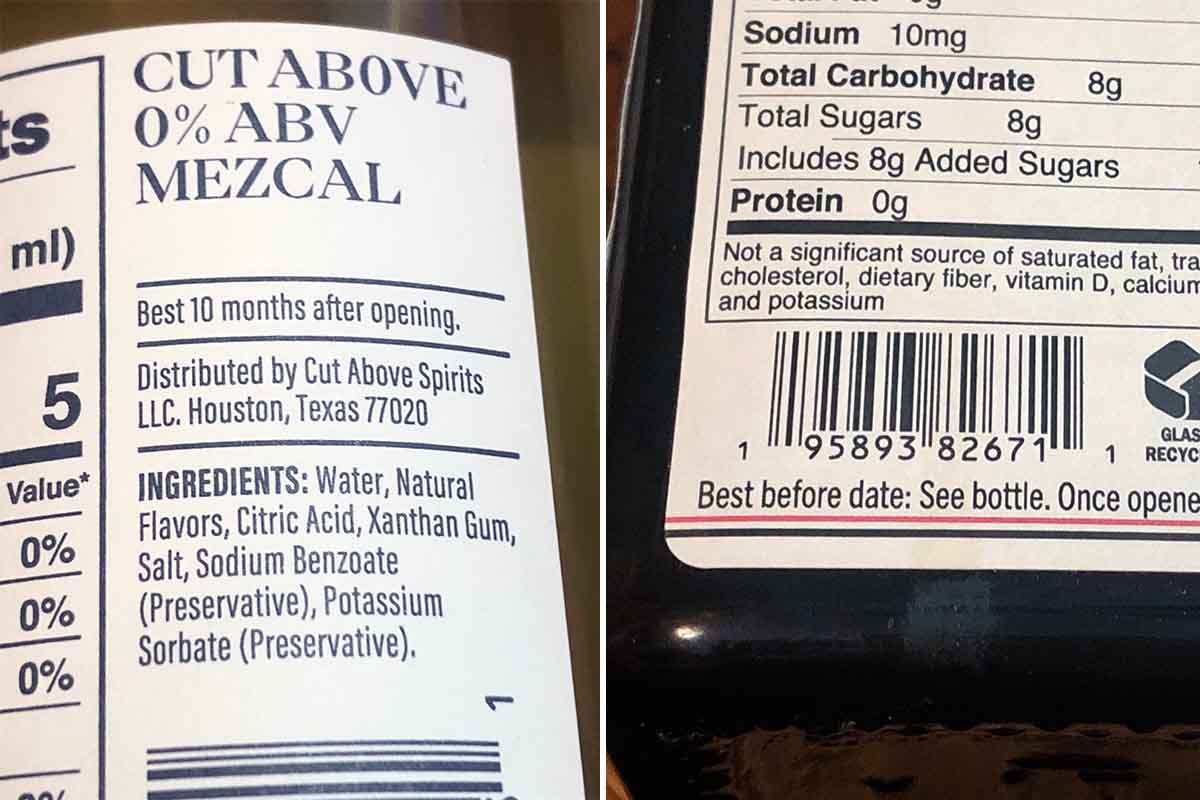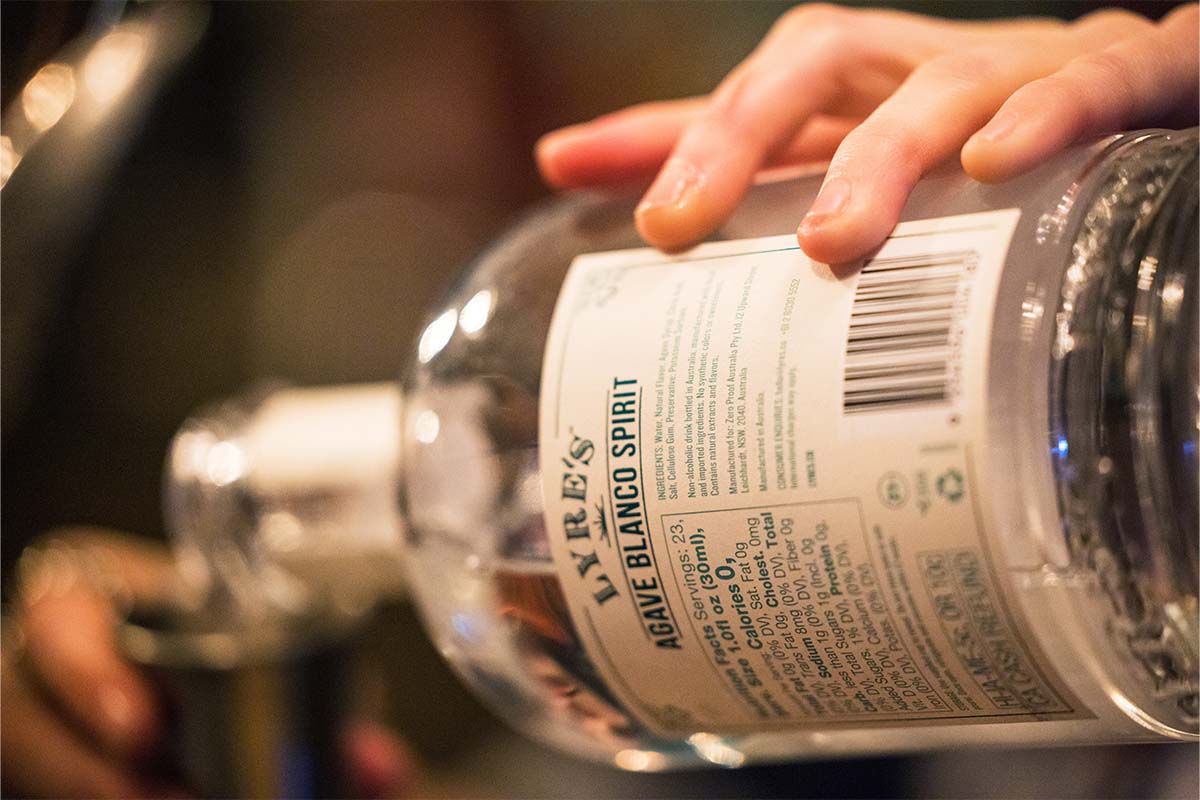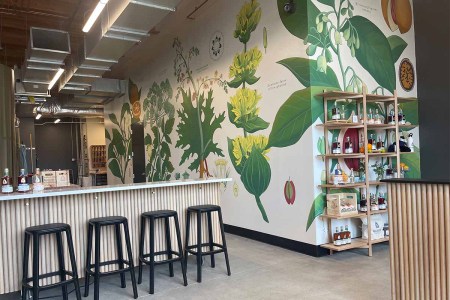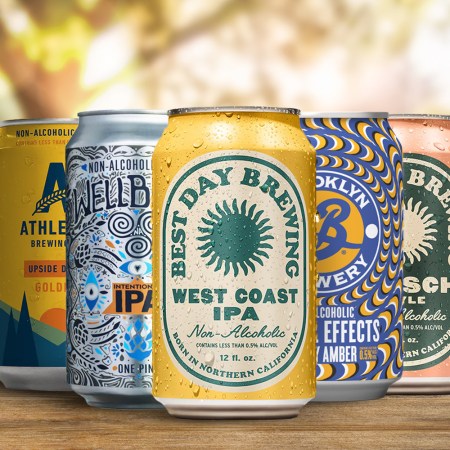The other day, I swung by my local mega liquor store and asked, “Do you carry zero alcohol spirits?” My question was aimed at how they’re organized (All in one place? With their respective boozy counterparts? In the alley?). I mean, obviously, by now stores are stocking a ton of no-alcohol (NA) labels, depending on the state. Right?
“We normally do, but right now we have only one because all the others expired in the warehouse and couldn’t be sold,” the clerk answered. Sorry, what?
But yes, it turns out the hottest trend in spirits has a sell-by date. I ran home (metaphorically) and checked my stash. Sure enough, on the back label of that bottle of Pathfinder: Best before date: See bottle. Once opened, drink within 3 months. I opened mine more than a year ago. My Damrak Virgin 0.0 Gin? March 2023 (in extremely tiny type). De Soi (pronounced “de swah”) Sparkling Non-Alcoholic Aperitif recommends refrigeration after opening. For Cut Above Zero Proof Mezcal, you find best 10 months after opening.

“NA spirits and zero proof spirits don’t have a required expiration date, but it’s good to have a ‘best before’ date,” says Andrew Solis, co-founder of Cut Above Spirits. “I think most of us do that.” Cut Above creates a number of zero-proof spirits, including whiskey, gin, and, most intriguingly, agave blanco (like tequila and mezcal).
Check out a specific product’s ingredients (they’re classified as a food item), and the “best by” dates make sense. The NA umbrella encapsulates different production methods: some are an infusion of fruits, herbs and spices in a viscous water, blended with thickeners like xanthan gum, glycerol or juice. Others actually are distilled, sometimes from an alcohol base that is then removed, sometimes infusions in a water base. Many, like the JAS ready-to-drink Paloma Libre, include ashwagandha, an herbal adaptogen that claims to create a relaxed vibe similar to those first few sips of alcohol.
No matter the process, they lack the high-alcohol content that acts as both a clarifier and preservative. Generally, a preservative like sodium benzoate or potassium sorbate is added to create a shelf-stable product and protect against yeast, mold and bacteria. “We use two preservatives,” Solis says. “We could have amped up the preservatives to give them a longer shelf life, but I didn’t think there was a need to keep a two-year-open product.” The result is an opened-bottle shelf life of nine to 10 months and unopened of 12 to 24 months.
“It surprises me a bit that people aren’t asking a lot of these sorts of questions,” says Seth O’Malley, co-founder of Wilderton Non-Alcohol Spirits. “People ask extremely detailed questions about their bourbon: What’s in the mash bill? Where is it produced? Is the corn non-GMO? But the goalposts for non-alcohol is ‘does it taste right’ and ‘does it work in a cocktail.’” O’Malley points to a general lack of transparency in the NA spirits space, and Wilderton aims to change that. The company recently opened the country’s first visitor-friendly, non-alcohol spirits distillery and tasting room in Hood River, OR. Visit, sample, ask all the questions: O’Malley and his team will answer.
The good news is your zero-proof booze isn’t going to poison you once it’s past the best-by date. Most or all products available don’t sour or spoil, they simply lose their oomph (though I personally wouldn’t play too fast and loose with juice-based products). “It’s never a safety issue, it’s more the quality of product,” Solis says. “I would say the intensity of the flavors diminishes slightly. With the mezcal, when you first open it, the smokiness hits you right up front. After 10 months, it’s slightly less impactful. You can still make a great cocktail, it’s just ‘less’ than what we want you to experience.”
Wilderton Is Opening the Country’s First Non-Alcoholic Tasting Room and Distillery Tour
It’s a milestone for the non-alc industryO’Malley concurs. “Freshness and safety often get lumped together,” he says. “With no-alcohol spirits, I usually think about the evaporation of flavor compounds and oxidation. Our Earth and Luster spirits are less sensitive to oxidation. But with our aperitif, like a vermouth, light and air will increase oxidation. It will last fine, but not taste as great.”
I’ve never been one to pay too much attention to expiration and sell-by dates (ask my long-suffering family when I cobble together dinner from whatever’s in the pantry). Most seem like guidelines on how much extra spice to add. Naturally, I dove into my year-expired Pathfinder while writing this article. It sips like a full-flavored aperitif: rich, herbaceous and bitter. Not only did it still taste great and offer up satisfying complexity, but I’ve sipped through several drams, and I’m as clear-headed as ever.
That said, it seems the right approach is to quaff your zero-proof gin or tequila as regularly as you might their alcohol-driven counterparts, rather than stashing them at the back of the bar.

O’Malley notes that careful producers are very focused on avoiding pathogens, bacterial growth and the sorts of things that can plague most food products. “As a producer, you could say, ‘Since this doesn’t have alcohol, you should consume it within 30 days and keep it refrigerated,” he says. “We opted not to do that because we think something that’s used as a spirit should be able to sit on your back bar and be stable, like a spirit.” Wilderton’s approach is to use “pretty conventional preservatives.”
Most bartenders haven’t had to worry about expiration dates. “To be honest, we go through Seedlip so fast we haven’t had a problem with it,” says Carl Brown at Kaiyo Rooftop in San Francisco. “I also don’t order excessive amounts, just enough for one or two weeks.”
“At Death & Co, we tend to keep them refrigerated after they’ve been opened and try and move through them within a few weeks,” says Matthew Belanger, bar manager at the famed bar’s LA outpost. “That said, most producers are confident their products will last quite a bit longer.”
A few hints and tips should help you enjoy your NA and zero-proof spirits even more:
- Store in a cool, dry place — light and heat are the enemies of all bottled products.
- Most NA spirits are designed to be mixed into cocktails, rather than sipped neat.
- Use them in recipes in the same amounts as regular spirits or liqueurs (though you can always increase the amount without any harmful effect).
- With fruit and cream-based NA liqueurs, refrigerate them after opening.
- Still concerned about shelf life? Consider Sayso, a cocktail “teabag” that can be used to create no-alcohol drinks or added to vodka to flavor it up. It should last as long as any spice or herb bag.
- Because this is a new category with multiple production methods, try several brands to find the styles that work best for you.
Every Thursday, our resident experts see to it that you’re up to date on the latest from the world of drinks. Trend reports, bottle reviews, cocktail recipes and more. Sign up for THE SPILL now.
























